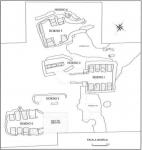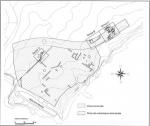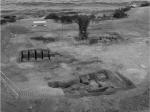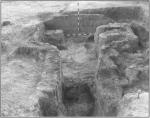Summary (English)
Excavation work carried out in the thermal area of La Marrana and the archaeological site of Los Tinteros has been possible through the Urban Planning Project of Isla Plana, in Cartagena. Construction of a seaside promenade had been considered here, as well as a protection and restoration plan of the existing architecture including the parish church.
The main objectives of this intervention have been, on the one hand, confirmation of the existence of archaeological remains in the seaside promenade area and, on the other hand, to define the remnants associated to the thermal area of Isla Plana and archaeological site of Los Tinteros.
Excavation work has resulted in findings on three areas. We have located a concentration of archaeological material from the late Roman imperial period on a specific area to which they were redeposited from their original place. Secondly, the eastern side of three chambers belonging to the contemporary period has been documented; it is believed they were fishermen’s dwellings with warehouses to store nets and other fishing gear. Lastly, we have identified a new area where remains of six adobe kilns have appeared, dating from between the 1st and 2nd centuries AD, and whose purpose was the production of common ceramics, tiles and bricks. From these kiln only the fire chamber remains, having lost completely the grate and baking chamber. They are of a rectangular plan and have side pilasters, also rectangular in two of their ends, and a central short wall in two of them. The praefurnium is composed of a corridor that narrows towards the exterior, forming the furnace opening. Moreover, these kilns are linked to two stockpiling areas of burned building material. The materials found in these areas are ash, debris and defective ceramic fragments from the cleaning of the kilns.
Work carried out on the seaside promenade and coast line has allowed us to delimit the area where Roman constructions from the archaeological site of Los Tinteros are concentrated. We have performed several sondages in this compound to select areas where an extended excavation could be carried out. This work has revealed an 80 m long drain that runs into the sea and that we associate with two basins located towards the middle of the drain; one of them is small and square while the other is semicircular and is paved with signinum.
Continuation of excavation works on this area during the 2007 campaign has allowed us to identify a series of houses from the archaeological site of Los Tinteros. The results from that new intervention are still being studied and analyzed.
(translation by Virginia González Martín & Sara María Cabrera Martín)
- Jesús García Guardiola y Eduardo López Seguí
Director
- Eduardo López Seguí
Team
- Jesús García Guardiola
Research Body
- Alebus Patrimonio Histórico SL






![Download [PDF]](/excavation/skins/fasti/images/results/download_sml.png)


